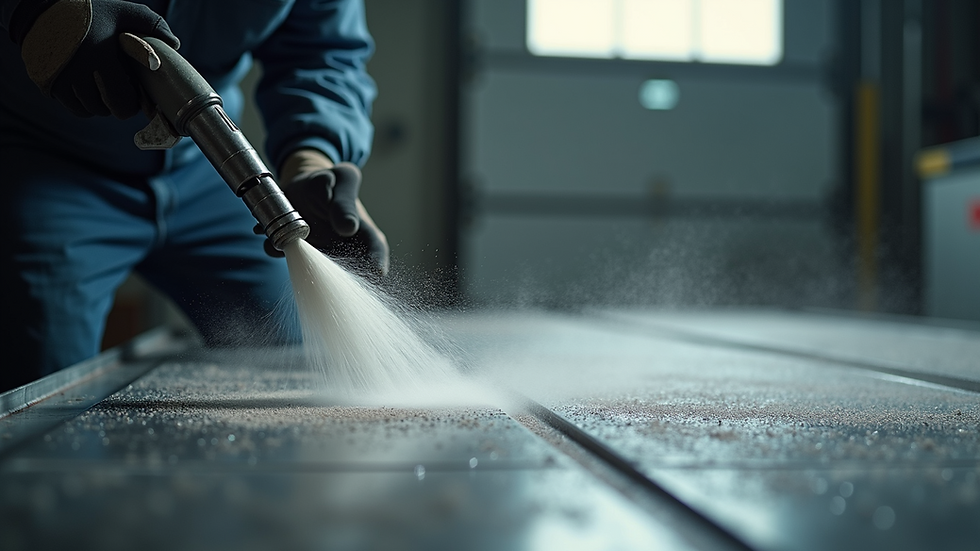Rust Removal Through Sandblasting Techniques
- Mound House Powder Coating

- Nov 2
- 4 min read
Rust can be a relentless enemy to metal surfaces. It eats away at strength, damages appearance, and shortens the lifespan of valuable equipment and structures. Over the years, I’ve seen countless methods to tackle rust, but one technique stands out for its efficiency and thoroughness: sandblasting. This process not only removes rust but also prepares the surface for a durable finish. In this post, I’ll walk you through everything you need to know about rust removal sandblasting, from how it works to whether you can do it yourself.
Understanding Rust Removal Sandblasting
Rust removal sandblasting is a powerful method that uses high-pressure abrasive materials to clean metal surfaces. The process involves propelling fine particles—often sand or other media—at high velocity against the rusted metal. This action strips away rust, old paint, and other contaminants, leaving a clean, roughened surface ready for coating or painting.
Why is this method so effective? Because it reaches every nook and cranny, even in hard-to-reach areas. Unlike manual scraping or chemical treatments, sandblasting provides a uniform finish and removes rust down to the bare metal. This ensures that any protective coating applied afterward will adhere properly and last longer.
Benefits of Sandblasting for Rust Removal
Thorough cleaning: Removes rust, scale, and old coatings completely.
Surface preparation: Creates a rough texture that improves coating adhesion.
Time-efficient: Faster than manual methods, especially on large surfaces.
Versatile: Works on various metals and shapes, from flat panels to intricate parts.

How Rust Removal Sandblasting Works in Practice
The sandblasting process starts with selecting the right abrasive media. While traditional sand is common, alternatives like glass beads, aluminum oxide, or steel grit may be used depending on the metal type and desired finish. The media is loaded into a blasting machine, which uses compressed air to shoot the particles at the surface.
Operators control the pressure and distance to avoid damaging the metal. For example, delicate parts require lower pressure and finer media, while heavy rust on thick steel can handle more aggressive blasting.
After blasting, the surface is inspected for cleanliness and texture. Any remaining dust or debris is removed, often with compressed air or a wipe-down. The metal is then ready for coatings like powder coating, paint, or specialized finishes such as CERAKOTE.
Practical Tips for Effective Sandblasting
Choose the right media: Match the abrasive to the metal and rust severity.
Control pressure carefully: Too high can damage metal; too low won’t clean effectively.
Maintain equipment: Regularly check hoses, nozzles, and compressors for optimal performance.
Wear protective gear: Sandblasting produces dust and debris that can harm eyes and lungs.

Can You Do Sandblasting Yourself?
Many people wonder if sandblasting is a DIY-friendly task. The answer depends on your experience, equipment access, and safety precautions. While small projects can be tackled at home with rented or purchased sandblasting kits, there are important considerations.
Pros of DIY Sandblasting
Cost savings: Avoid professional service fees.
Convenience: Work on your own schedule.
Learning experience: Gain hands-on knowledge of metal restoration.
Cons and Risks
Safety hazards: High-pressure abrasives can cause injury without proper gear.
Equipment costs: Quality blasting machines and media can be expensive.
Skill requirement: Improper technique can damage metal or leave rust behind.
Cleanup: Dust and debris require thorough containment and disposal.
If you decide to try it yourself, start with small, non-critical items. Always wear a respirator, gloves, and eye protection. Work in a well-ventilated area or use a blasting cabinet to contain dust. Follow manufacturer instructions carefully.
For larger or valuable projects, I recommend professional services. Experts have the right tools, experience, and safety measures to deliver superior results efficiently.
Choosing the Right Sandblasting Service for Your Rust Removal Needs
When selecting a professional sandblasting provider, consider these factors:
Experience and reputation: Look for companies with proven expertise in rust removal sandblasting.
Equipment quality: Modern, well-maintained machines ensure consistent results.
Media options: Providers offering various abrasives can tailor the process to your project.
Additional services: Some companies also provide coating or finishing services, streamlining your project.
Customer reviews: Feedback from previous clients can reveal reliability and quality.
At Mound House Powder Coating, for example, we combine over 30 years of metal finishing expertise with advanced sandblasting techniques. Our team ensures every project is masterfully crafted for durability and aesthetic appeal. We also offer specialized finishes like CERAKOTE to protect your metal long after rust removal.
If you want to learn more about professional options, check out this resource on sand blasting for rust removal.
Maximizing Longevity After Rust Removal Sandblasting
Removing rust is only the first step. To protect your metal and extend its life, proper finishing is essential. Here are some strategies I recommend:
Apply a primer: Use a rust-inhibiting primer immediately after blasting to prevent flash rust.
Choose durable coatings: Powder coating, CERAKOTE, or industrial paints provide strong protection.
Regular maintenance: Inspect and clean metal surfaces periodically to catch early signs of rust.
Environmental control: Minimize exposure to moisture and corrosive elements when possible.
By combining expert rust removal sandblasting with high-quality finishing, you ensure your metal assets remain strong and visually appealing for years.
Rust removal sandblasting is a game-changer for anyone dealing with corroded metal. Whether you’re restoring industrial equipment, automotive parts, or architectural elements, this technique offers unmatched cleaning power and surface preparation. With the right knowledge, tools, and professional support, you can achieve durable, beautiful metal finishes that stand the test of time.




Comments